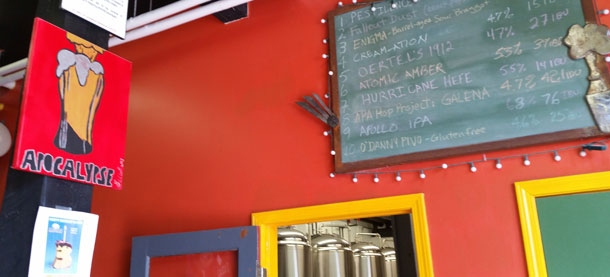
Reuben Gray hosts the 100th gathering of The Session and asks blogs to write about “Resurrecting Lost Beer Styles.” Visit his site for links to other contributions.
 When David Pierce set out to brew the first commercial batch of Kentucky Common in, well nobody knows how many, years “it was still back when we all thought it (had been) a sour beer.” That was 1994 and Pierce was brewmaster at Bluegrass Brewing Co. in Louisville.
When David Pierce set out to brew the first commercial batch of Kentucky Common in, well nobody knows how many, years “it was still back when we all thought it (had been) a sour beer.” That was 1994 and Pierce was brewmaster at Bluegrass Brewing Co. in Louisville.
We’ve since learned the idea that the process used to brew Kentucky Common in the early years of the twentieth century included a sour mash is just plain wrong. But, going on the best information anybody had to offer, Pierce began with a 100 percent sour mash, mashing in hot one night and arriving to a horrific smell at the brewery the next day. It was not an easy beer to sell. Roger Baylor at Rich O’s Public House in New Albany, across the Ohio River from Louisville, did his best to support a beer he thought was historically important. He promoted it as “beer formaggio.”
Pierce made the beer periodically in the following years before he left BBC to work for Baylor at New Albanian Brewing. He refined the process, souring only part of the mash, creating a beer than wasn’t as pungent. He thought the fifth, and last, batch was probably the best. “We couldn’t give it a way,” he said. Then somebody suggested they call it a Belgian sour brown ale. The last seven barrels (14 kegs) sold out in a week.
In the years since, meticulous research by Leah Dienes, Dibbs Harting, and Conrad Selle established that if Kentucky Common occasionally turned out sour in the marketplace in the years before Prohibition it wasn’t on purpose, and it certainly wasn’t made using a sour mash. That is reflected in the recently released BJCP Style Guidelines. Kentucky Common is in Category 27, Historical Beers, and the guidelines even specify “Enter soured versions in American Wild Ale.” That works fine for judging in a homebrew competition, particularly in a historic context, but what about modern day commercial beers? Kentucky Common now has a 20-year history in which a sour mash is used in the brewing process.
Granted the modern history is limited. However, if you are looking for a “Kentucky Common” brewed in Kentucky and sold outside of Kentucky it is going to be Against the Grain’s Kamen Knuddeln, which is a blend of a young sour-mashed beer and a barrel-aged stout. Jerry Gnagy gets a lactobacillus starter from Four Roses Bourbon for the sour mash. It makes perfect sense that had Kentucky Common been brewed continuously for a hundred-and-some years that it might evolved or at least different versions would have emerged. Using lacto from a nearby distillery? Makes sense. Include a portion of beer aged in bourbon barrels? Also indigenous.
Last month, as part of the Derby City Brewfest it hosted, Bluegrass Brewing invited participating breweries to make a Kentucky Common. Eight Commons ended on offer, some sour, some not. Because we were in Kentucky the following week I got a chance drink several of them. I certainly could have wasted a larger chunk of an afternoon than I did drinking New Albanian’s Phoenix Kentucky Komon and chatting with Baylor (who has currently stepped away from the business while he runs for mayor of New Albany). It is not an easy beer to make, and the brewery does it just once a year on its smaller four-barrel system — yes, four barrels a year; like I wrote, a pretty limited modern history. “It’s one of my roughest mashes of the year,” brewer Ben Minton said, in this case because of the percentage of corn and temperamental false bottom in the mash tun. “It comes out a little different every time.”

Two historic (in other words, not sour) versions I had at Apocalypse Brewing were equally delightful. Dienes had her Oertel’s 1912, which is based on the records in Oertel’s brewing logs and the only example of the style in the BJCP guidelines, on tap. Harting brought his homebrewed version. It is the only beer he struggles to keep on tap. “Oh dad, can I take a common home?” Harting said, quoting one of his children. “I’m sure it was a fabulous bucket (growler) beer,” he added.
This works for me. Kentucky Common of the past. Kentucky Common of the present. Kentucky Common of the future. There doesn’t have to be just one.
 Here is a chilling thought: “If this trend of reducing the hop-content in (German) Pilsner beer continues, by 2030 the Pilsner beer will have similar composition to today’s export or lager beers.”
Here is a chilling thought: “If this trend of reducing the hop-content in (German) Pilsner beer continues, by 2030 the Pilsner beer will have similar composition to today’s export or lager beers.”
 When David Pierce set out to brew the first commercial batch of Kentucky Common in, well nobody knows how many, years “it was still back when we all thought it (had been) a sour beer.” That was 1994 and Pierce was brewmaster at Bluegrass Brewing Co. in Louisville.
When David Pierce set out to brew the first commercial batch of Kentucky Common in, well nobody knows how many, years “it was still back when we all thought it (had been) a sour beer.” That was 1994 and Pierce was brewmaster at Bluegrass Brewing Co. in Louisville. 